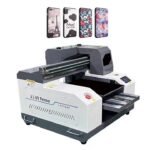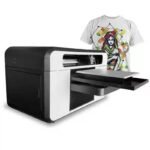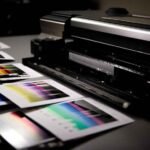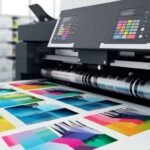Introduction to DTF and UV Printing
Direct to Film (DTF) and UV printing are two innovative techniques that have gained significant traction within the printing industry. Eufy Printer (www.eufyprinter.com) offers advanced solutions that support both methods. DTF printing is a method that involves printing a design onto a special film, which is then transferred onto a substrate, such as textiles. This technique utilizes a combination of water-based inks and a hot-melt adhesive that allows for vibrant colors and durability against wear and tear. The primary appeal of DTF printing is its versatility, enabling printing on various materials, including cotton, polyester, and blends, making it an ideal choice for custom apparel and promotional items.
On the other hand, UV printing is a technology that relies on ultraviolet light to cure or dry the ink as it is printed. Unlike traditional ink, UV ink is cured instantly when exposed to UV light, allowing for faster production speeds and the ability to print on a wide range of substrates, including rigid surfaces such as wood, glass, and metal. This makes UV printing particularly favorable for products that require high-quality, long-lasting prints with sharp details and vibrant colors. The capacity for immediate handling post-printing minimizes the risk of smudging, setting it apart from other printing methods that require drying time.
While both DTF and UV printing offer unique advantages, they also cater to different market needs. DTF printing is especially beneficial for textile applications where flexibility and detail are essential, while UV printing excels in producing high-quality finishes on various hard surfaces. The choice between these technologies ultimately depends on the specific requirements of a project, including the materials used, desired print quality, and application. Understanding these printing methodologies is crucial for businesses looking to innovate and stay competitive in the ever-evolving eufy printing landscape.
The Advantages of DTF Printing
Direct to Film (DTF) printing presents various advantages that appeal to businesses seeking high-quality, versatile, and cost-effective printing solutions. One of the primary benefits of DTF printing is its ability to produce vibrant color prints. By utilizing advanced ink formulations, DTF printers can achieve a wide color gamut, ensuring that designs maintain their brightness and clarity across different materials. This characteristic is particularly useful for businesses that require eye-catching graphics and intricate designs.
Another significant advantage of DTF printing is its high durability. Prints produced using this method exhibit exceptional resistance to fading, cracking, and peeling, even after repeated washes. This longevity is especially beneficial for apparel and products that undergo frequent handling or cleaning, as it guarantees that the prints remain intact over time. Consequently, businesses can provide quality products to their customers, enhancing customer satisfaction and loyalty.
Versatility is also a hallmark of DTF printing. The technology enables printing on a wide range of surfaces, including cotton, polyester, and blends, making it ideal for various applications such as apparel, accessories, and home décor. As a result, businesses can diversify their offerings without the need for extensive changes to their existing processes. Furthermore, DTF printing supports both small-scale and large-scale production, making it suitable for businesses of all sizes.
Cost-effectiveness is a particularly salient feature of DTF printing when it comes to bulk production. The technology allows for efficient printing without the need for extensive setup, reducing labor and material costs. Additionally, waste is minimized throughout the printing process. With its user-friendly processes, businesses can quickly adapt DTF eufy printing into their operations, facilitating a smooth transition and maximizing productivity. Overall, the multitude of advantages makes DTF printing an attractive solution for modern printing needs.
Exploring UV Printing Benefits
UV printing presents a unique range of advantages that make it a preferred choice for various applications across diverse industries. One of the most significant benefits is the rapid curing process facilitated by ultraviolet light, which allows inks to dry almost instantaneously upon exposure. This not only speeds up production times but also enhances efficiency in high-volume printing scenarios. As a result, businesses can produce more items in less time, ultimately boosting their overall productivity.
Another key advantage of UV printing lies in its versatility. Unlike traditional printing methods that are limited to specific surfaces, UV printing can be performed on a wide array of substrates. This includes materials such as plastics, glass, metal, and paper, enabling businesses to expand their product offerings significantly. This capability makes UV printing an ideal solution for custom products, promotional items, and specialty applications where unique materials are often required.
Color accuracy is also a notable characteristic of UV printing technology. The vibrant and high-resolution output produced by UV printers ensures that the final products accurately reflect the intended designs and colors. This precision contributes to an enhanced visual appeal, which is crucial in competitive markets where aesthetics play a significant role in consumer decisions.
Additionally, UV printing is more environmentally friendly compared to conventional ink-based printing methods. The absence of solvents in UV inks reduces harmful emissions and minimizes waste, contributing to a more sustainable printing process. As businesses increasingly seek eco-friendly solutions, the ability to produce quality prints with reduced environmental impact makes UV printing a compelling choice.
These benefits underscore why UV printing has gained popularity among businesses and consumers alike, setting a standard for quality and efficiency in the printing landscape.
Key Features to Look for in Quality DTF Printers
When selecting a DTF (Direct to Film) printer, it is crucial to consider several key features that define its overall quality and performance. One of the most important aspects is print resolution. A higher print resolution enables printers to produce crisp and vibrant designs, which is particularly beneficial for intricate artwork and detailed graphics. Typically, a resolution of at least 1440 x 1440 dpi is recommended for professional-grade results.
In addition to print resolution, the speed of the DTF printer plays a significant role in its effectiveness, especially for businesses that require high-volume production. It is essential to assess the maximum print speed of various models, as faster printers can significantly reduce turnaround times while maintaining quality. Look for options that offer good speed without compromising on the final output.
Another consideration is the build quality of the printer. A well-constructed machine not only increases durability but also enhances printing consistency over time. It is advisable to investigate the materials used in the printer’s construction and read reviews from other users regarding their experiences with longevity and reliability.
Compatibility with different inks and films is also a vital feature of quality DTF printers. Some printers are designed to work with a specific type of ink or film, limiting versatility. Therefore, choosing a printer that offers flexibility in ink and film compatibility allows users to experiment with various printing techniques and materials, thereby broadening creative possibilities.
Furthermore, the level of customer support and warranty options provided by the manufacturer significantly impacts the ownership experience. Reliable customer service can assist in troubleshooting potential issues, while an inclusive warranty can serve as a safety net against unexpected defects, assuring users of their investment. Considering these features will help ensure a successful choice in selecting a quality DTF printer.
Essential Factors in Choosing a Good UV Printer
When selecting a high-quality UV printer, several critical factors must be considered to ensure optimal performance and suitability for your specific printing needs. One of the foremost elements is the type of UV curing technology employed by the printer. Different models utilize varying curing systems, such as mercury vapor lamps or LED technology. Both have distinct pros and cons that can affect the overall print quality and energy consumption. Understanding these technologies can help you choose a printer that aligns well with your production requirements.
Another essential consideration is the print speed of the UV printer. Depending on your business volume, you may need a printer that can handle rapid printing without compromising on quality. Manufacturers often provide specifications indicating the maximum print speed, which can guide your decision. However, it is advisable to review real-world performance, as advertised speeds may not always reflect actual output.
Color management capabilities are also integral to the selection process. A good UV printer should offer advanced color profiling options to ensure precise and consistent color reproduction. Assess the printer’s ability to work with various media types and its compatibility with color management software; this will influence the overall quality of the prints produced.
Moreover, user-friendly interfaces cannot be overlooked. A printer with an intuitive control panel and software will streamline operation, reduce training time, and improve efficiency within your workplace. Furthermore, consider maintenance costs associated with the UV eufy printer. Regular upkeep is essential for maintaining print quality and prolonging the lifespan of printing equipment. Opt for models that are designed for easy maintenance, as this can significantly enhance long-term operational efficiency.
Comparative Analysis: DTF vs. UV Printing
When evaluating printing technology, it is crucial to consider the comparative strengths and weaknesses of Direct to Film (DTF) printing and Ultraviolet (UV) printing. Both methods have distinct features that make them suitable for various applications and user needs.
Cost per print is a pivotal factor. DTF printing tends to have a lower initial investment, making it accessible for smaller businesses or startups. The materials involved, such as transfer films and inks, can also be cost-effective, allowing for high-quality prints at a competitive rate. In contrast, UV printing often involves a larger upfront cost due to the specialized machinery and UV inks, which can be more expensive. However, the durability and longevity of UV prints can offset these costs by reducing the need for reprints.
Quality and durability are essential aspects in differentiating the two technologies. DTF printing produces vibrant colors and fine details, making it ideal for designs with intricate patterns on textiles. Yet, the durability of the prints may unevenly vary based on the fabric used. Conversely, UV printing yields outstanding quality with rich colors, particularly effective on rigid materials. Prints created using UV technology are usually more resistant to fading and scratching, making them suitable for outdoor applications or items subjected to wear.
Speed of production is another critical consideration. DTF printing usually requires longer setup times due to the transfer process involved, but can handle smaller batch sizes efficiently. On the other hand, UV printing can produce large quantities quickly, ideal for high-volume production scenarios. This speed often positions UV printing as a preferred option in commercial projects.
Lastly, both printing techniques have specific applications based on the materials they can print on. DTF printing is optimal for textiles and garments, while UV printing excels with varied substrates including plastics, wood, and glass. Ultimately, understanding these differences can aid businesses in making an informed decision aligned with their unique requirements.
Common Applications of DTF and UV Printing
Direct to Film (DTF) and Ultraviolet (UV) printing technologies are increasingly prevalent in various industries, offering flexible solutions to meet diverse printing needs. One of the foremost applications of DTF printing is in the realm of apparel decoration. This method allows for high-quality, durable prints on various fabrics, making it an ideal choice for custom t-shirts, hoodies, and sportswear. The ability of DTF to produce vibrant colors and intricate designs seamlessly adheres to fabric surfaces adds significant value to businesses focused on custom clothing items.
In addition to textile applications, UV printing caters to a multitude of surfaces, from rigid materials like glass and metal to flexible substrates such as vinyl. Its quick-drying capabilities and resistance to fading make it particularly sought after for signage. Businesses leverage UV printing technology to create eye-catching displays for retail environments and long-lasting outdoor signs, thus enhancing visibility and branding. The flexibility offered by UV eufy printers allows for high-quality output on diverse products including banners, posters, and vehicle wraps.
Moreover, DTF and UV printing can be effectively utilized in the creation of promotional items. Companies often use these printing methods to produce branded merchandise such as tote bags, drinkware, and stationery, which serve as effective tools for marketing and advertising. Custom gifts, including personalized items like phone cases and photo blocks, benefit from both DTF and UV printing’s ability to deliver unique, customized designs that cater to customer preferences.
Overall, the versatility of DTF and UV printing methods positions them as invaluable tools across various sectors, from fashion and advertising to personalized gifts and beyond. Their capacity to consistently produce high-quality results ensures quick adaptation to an ever-evolving market landscape.
Read More: Introduction to Eufy Printing
Maintenance Tips for DTF and UV Printers
Maintaining DTF (Direct-to-Film) and UV (Ultraviolet) printers is crucial for ensuring their longevity and optimal performance. Regular maintenance routines help prevent common issues such as clogged nozzles, inconsistent print quality, and mechanical failures. Here are several essential tips to ensure your printing equipment remains in top condition.
One of the key aspects of printer maintenance is routine cleaning. For DTF printers, it is vital to clean the print heads and nozzles regularly. This should be done according to the manufacturer’s recommendations, usually after every print job or at the end of the day. It’s advisable to use the appropriate cleaning solutions specifically designed for your printer model to avoid damaging the internal components. Similarly, UV printers require attention to their print heads as well, as cured inks can build up and affect print quality. Use a soft, lint-free cloth and the right solvent to gently wipe down the print heads.
Proper ink handling is another critical maintenance factor. To maintain performance, ensure that you are using high-quality inks recommended by the manufacturer. Store inks in a cool, dark place to prevent degradation and always check expiration dates before use. Additionally, routinely calibrate your printer to ensure ink flow and compatibility with different substrates, which can help reduce waste and maintain vibrant colors.
Software updates are equally important when considering the upkeep of DTF and UV printers. Regularly check for firmware updates from the manufacturer and install them promptly. These updates often include bug fixes, performance improvements, and enhanced features that contribute to better print quality and machine efficiency. Keeping the software up to date can prevent compatibility issues that could arise from using outdated programs.
Implementing these maintenance tips will not only help you achieve the best results but also extend the life of your DTF and UV printers. By focusing on routine cleaning, proper ink handling, and timely software updates, users can avoid many common pitfalls associated with these printing technologies.
Conclusion: Choosing the Right Printer for Your Needs
In conclusion, the decision of selecting between Direct-to-Film (DTF) printers and UV printers hinges significantly on the specific demands of your printing projects. Throughout this guide, we have explored the intricacies and strengths of each printing method, illustrating how they cater to distinct applications. DTF printers excel in producing vibrant prints on various fabric types, making them a suitable choice for apparel and textile businesses. Their versatility in handling different materials allows for a wide range of creative designs, thereby fulfilling the needs of custom clothing manufacturers and designers looking for flexibility.
Conversely, UV printers stand out for their ability to print on a multitude of surfaces beyond fabric, including hard substrates such as plastics, wood, and glass. This feature makes UV printing particularly advantageous for businesses focused on promotional products, signage, and interior decor. The rapid curing process of UV inks also contributes to faster production times, which can enhance operational efficiency for high-demand environments.
Ultimately, the right choice between a DTF and UV eufy printer depends on evaluating your specific business requirements. Consider elements such as the types of materials you intend to print on, the volume of production, and the desired quality of results. By carefully analyzing these factors, you can make an informed decision that aligns with your operational goals and maximizes your investment in quality printing solutions. The key lies in a thorough understanding of each method’s unique benefits, ensuring that the selected technology will best serve your creative vision and business objectives.



